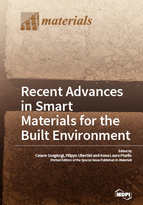Recent Advances in Smart Materials for the Built Environment
A special issue of Materials (ISSN 1996-1944).
Deadline for manuscript submissions: closed (30 June 2018) | Viewed by 55717
Special Issue Editors
Interests: pavements; bituminous materials; recycled materials; innovative paving materials
Special Issues, Collections and Topics in MDPI journals
Interests: smart concretes; smart bricks; bridge SHM; earthquake-induced damage detection; vibration-based SHM
Special Issues, Collections and Topics in MDPI journals
Interests: energy efficiency; smart materials; environmental sustainability; buildings; renewable energy; environmental comfort
Special Issues, Collections and Topics in MDPI journals
Special Issue Information
Dear Colleagues,
The built environment of the future is expected to need novel smart and multifunctional construction materials that provide a variety of other features, in addition to strength and durability. In this view, many researchers worldwide are focusing on the development of such innovative and highly promising solutions with the purpose to enhance the construction material behavior in terms of environmental sustainability and technical performance including the new frontiers of self-sensing, self-healing, energy harvesting, overheating control, noise reduction, microclimate mitigation, and other capabilities.
Society itself will be the first beneficiary of such scientific discussion, since it will take advantage from these characteristics that will allow saving raw materials and energy, minimizing the externalities of construction, service and maintenance phases and impact. Furthermore, those solutions are expected to transform the physical and mechanical behavior of structural and non-structural elements into precious sources of data, renewable energy along with other functional advantages, such as noise and urban overheating reduction.
This Special Issue aims at presenting a number of high-quality up-to-date research contributions that have proven benefits and feasibility of smart materials in the built environment at large. Technical papers, review contributions and case histories on laboratory and in-situ experiments are all welcome. By acknowledging your important contribution in these fields, we would like to warmly invite you to submit a manuscript for consideration in the “Recent Advances in Smart Materials for the Built Environment” Special Issue in Materials.
Prof. ing. Cesare SangiorgiProf. ing. Filippo Ubertini
Prof. ing. Anna Laura Pisello
Guest Editors
Manuscript Submission Information
Manuscripts should be submitted online at www.mdpi.com by registering and logging in to this website. Once you are registered, click here to go to the submission form. Manuscripts can be submitted until the deadline. All submissions that pass pre-check are peer-reviewed. Accepted papers will be published continuously in the journal (as soon as accepted) and will be listed together on the special issue website. Research articles, review articles as well as short communications are invited. For planned papers, a title and short abstract (about 100 words) can be sent to the Editorial Office for announcement on this website.
Submitted manuscripts should not have been published previously, nor be under consideration for publication elsewhere (except conference proceedings papers). All manuscripts are thoroughly refereed through a single-blind peer-review process. A guide for authors and other relevant information for submission of manuscripts is available on the Instructions for Authors page. Materials is an international peer-reviewed open access semimonthly journal published by MDPI.
Please visit the Instructions for Authors page before submitting a manuscript. The Article Processing Charge (APC) for publication in this open access journal is 2600 CHF (Swiss Francs). Submitted papers should be well formatted and use good English. Authors may use MDPI's English editing service prior to publication or during author revisions.
Keywords
- Smart materials
- Self-sensing
- Energy harvesting
- Self-healing
- UHI mitigation
- Acoustic materials









